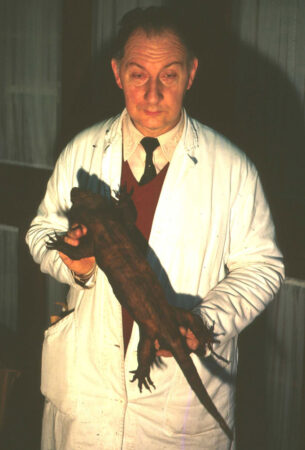DNA has revealed the origin of this giant ‘mystery’ gecko
A lizard called Delcourt’s giant gecko has long been one of herpetology’s biggest mysteries — literally.
Presumed extinct, the animal is by far the largest gecko known to have crawled the Earth, measuring at least 600 millimeters, or about two feet, from snout to tail tip. The only example scientists have of the gecko, however, is a single museum specimen, preserved in the 19th century with no notes as to its origin or identity.
Now, DNA from the specimen reveals that the colossal lizard belongs to a group of New Caledonian “diplodactylid” geckos, researchers report June 19 in Scientific Reports. Geckos in this lineage repeatedly evolved extreme body sizes on the archipelago east of Australia.
“Compared to all other geckos, it’s monstrous,” says Matthew Heinicke, an evolutionary biologist at the University of Michigan-Dearborn. “It happens to be in a lineage where evolution of gigantism wasn’t a one-off event.”

Previously dubbed Hoplodactylus delcourti, the gecko was renamed Gigarcanum delcourti in the new study, placing the animal in its own genus whose name means “giant mystery.” It is about 50 percent longer and several times heavier than the largest living gecko species (Rhacodactylus leachianus), also a member of the New Caledonian group.
Likely a nocturnal hunter, G. delcourti was big enough to prey on birds and lizards, including other geckos. Its toe pads and long claws suggest it lived in trees, though it was probably the maximum size at which a gecko could still adhere to vertical surfaces with its hallmark sticky grip, Heinicke says.
The gecko came to scientists’ attention in the 1980s after collections manager Alain Delcourt found the long-forgotten specimen at the Natural History Museum of Marseille in France. Stuffed rather than stored in spirits, the gecko sports a thick trunk, bulbous head and brown skin with faint red bands. Herpetologist Aaron Bauer of Villanova University in Pennsylvania was a graduate student when he arrived at the museum in 1983 to investigate the newly rediscovered specimen.
When Delcourt removed the enormous gecko from a cabinet, “my jaw dropped,” Bauer says.
Bauer cowrote the first description of the species in 1986, placing the reptile with a New Zealand gecko group based on its physical characteristics. He also suggested that because of its coloring and size, the gecko could be the kawekaweau — a huge arboreal lizard from the folklore of the Indigenous Māori people.

Since then, techniques for retrieving and analyzing archival DNA have accelerated, allowing scientists to glean new information from degraded museum specimens, including of extinct species such as the dodo and thylacine, also known as the Tasmanian tiger (SN: 5/19/08).
Heinicke, Bauer and colleagues revisited the mysterious giant gecko, extracting and analyzing DNA from one of its femurs. That genetic material rewrote G. delcourti’s origin story, showing that it is not even closely related to New Zealand’s geckos. The diplodactylid geckos of New Caledonia and New Zealand are separated by about 45 million years of evolution.
The team’s finding “turns things on their head,” as gecko geeks worldwide have long associated G. delcourti with New Zealand, says Paul Doughty, a herpetologist at the Western Australian Museum in Perth. “But this is the thing about these precious museum specimens. With new technology, they can give up new secrets.”
Not everyone is surprised by the finding. Trevor Worthy, a paleontologist at Flinders University in Adelaide, Australia, previously suggested that G. delcourti may have come from New Caledonia, given its absence in New Zealand’s extensive fossil record. “You would think that … such a big animal would have turned up, and there was no sign of it,” Worthy says. “It’s exciting to see this mystery cleared up.”
Could G. delcourti still be nestled in the treetops of New Caledonia?
It’s unlikely, but possible, the researchers say. New geckos continue to be discovered on the islands. “I’d like to hold out at least a tiny glimmer of hope that there could be something out there,” Bauer says.
For all the latest Science News Click Here
For the latest news and updates, follow us on Google News.

